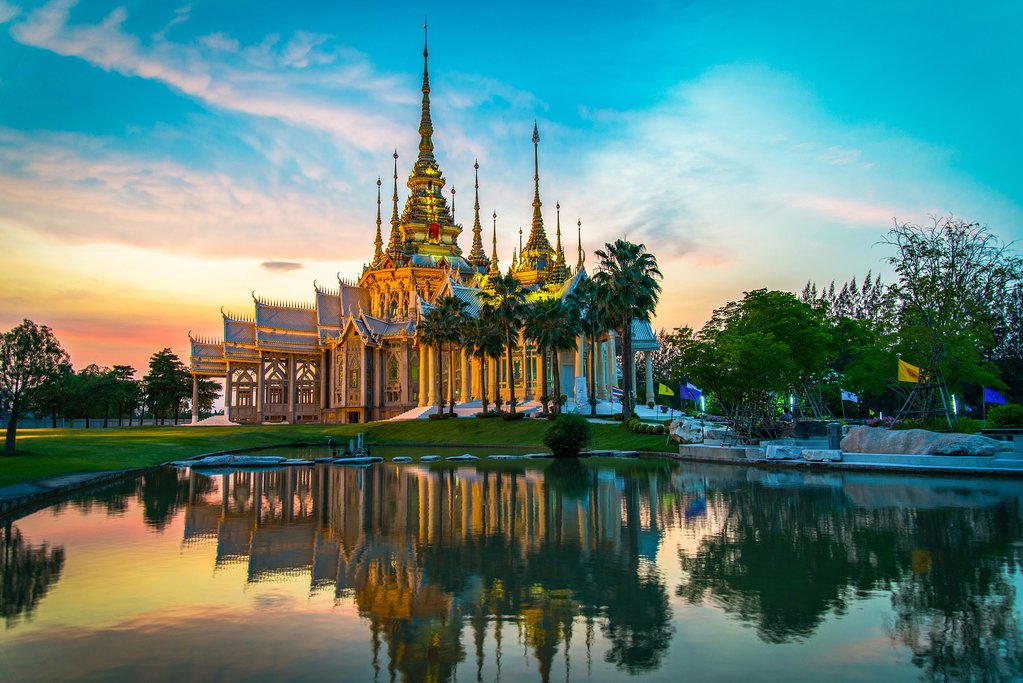
Thailand is a long country, with mountains in the north and beautiful beaches in the south. It’s almost uniformly hot, but some times of year are much hotter (and wetter) than others. Thailand is busiest (unsurprisingly) when the weather is at its best, from November to March. During low season, you should expect heavy rain, but that doesn’t mean you can’t have a good time—you just need to know where to go. Here are some tips to know about the best time of year to visit Thailand.
## Navigating Thailand’s Seasons: A Comprehensive Guide
Thailand, a land of captivating contrasts, presents a diverse tapestry of regional experiences. From the majestic, verdant mountains of the north to the idyllic, sun-kissed tropical beaches of the south, the country offers a wealth of attractions. However, understanding Thailand’s distinct seasonal patterns is crucial for planning an unforgettable trip. Unlike many Western countries with their clear-cut spring, summer, fall, and winter, Thailand primarily experiences two main seasons: the wet and the dry, often referred to as the hot and the cool seasons respectively.
It’s important to remember that the terms “hot” and “cool” are relative. Temperatures tend to be milder during the dry season and warmer during the wet season. However, this simplified view can be misleading, as the reality is more nuanced.
The complexity arises from the fact that these seasons don’t neatly coincide across the various regions of Thailand. A season that is prevalent in one region of Thailand may differ significantly from another area. So, when contemplating your travels in Thailand, it’s absolutely essential to consider these regional variations. Imagine planning a relaxing beach getaway only to find yourself caught in relentless downpours – a scenario easily avoided with careful consideration of the seasonal weather patterns.
While temperature variations throughout the country and across the year may seem minimal on paper, the reality experienced by travelers can be very different. Average high temperatures during the cool/dry season hover around a comfortable 84°F (29°C), while the hot/wet season can see temperatures rise to a sweltering 96°F (36°C). Most locations typically experience temperatures within this range for the majority of the year. Therefore, simply traveling to Thailand during the “cool season” doesn’t guarantee a particularly chilly experience.
However, the amount of rainfall varies dramatically between the seasons, even if the temperature differences are not that significant, and that has the greatest impact on comfort. This significant fluctuation in rainfall can profoundly influence your comfort levels and the overall quality of your trip. Imagine exploring ancient temples under a clear, blue sky versus battling torrential rain – the difference is palpable.
The peak tourism season in Thailand aligns with the cool/dry season, drawing in a significant influx of visitors. However, it’s more accurate to categorize the earlier and later months of this extended period, spanning from November to March, as shoulder seasons. These shoulder seasons offer a sweet spot, balancing pleasant weather with potentially fewer crowds.
Here’s a detailed breakdown of the seasons:
| **Season** | **Months** | **Average Highs** | **Pros** | **Cons** | **Best for** | **Where to Visit** |
|—|—|—|—|—|—|—|
| **Hot/Wet** | April-October | 96°F/36°C | Fewer tourists, lush countryside | Rainy, not ideal for beach destinations | Cultural and city sightseeing | Bangkok, Ayutthaya, Chiang Mai, Chiang Rai |
| **Cool/Dry** | Nov-March | 84°F/29°C | Ideal beach weather | Influx of tourists | Beach time, outdoor activities | Southern Thailand |
**Plan your trip to Thailand with Expert Local Guidance**
Embark on an extraordinary journey to Thailand with the invaluable assistance of a local specialist who can meticulously organize every detail of your trip, ensuring a seamless and unforgettable experience.
## Cool/Dry Season (November-March): The Prime Time for Beach Bliss
The cool/dry season in Thailand provides consistently agreeable weather across the country. It’s important to clarify that the “cool” designation is relative; it signifies a cooler period in comparison to the hotter wet season, typically only a few degrees cooler on average. Temperatures in Thailand rarely drop to genuinely cool levels, unless you ascend to higher elevations in the mountains. This season is perfectly suited for enjoying a quintessential Thai beach vacation.
The period from November to February represents the peak season for tourism in Thailand. As one of Asia’s most sought-after travel destinations, the term “peak season” truly reflects the increased numbers of visitors. This can mean higher prices and larger crowds at popular attractions. However, many tourists tend to concentrate on a limited number of highly developed destinations. If you are looking to experience a more tranquil retreat and are willing to invest extra time in traveling to less-visited locales, you can discover beaches, islands, and mountain regions that are not overwhelmed by mass tourism. Consult with a local specialist who can offer tailored recommendations aligned with your specific interests and requirements.
As March approaches, temperatures gradually increase, becoming quite hot in central and southern Thailand, although rainfall remains relatively low. However, traveling to Northern Thailand later in the cool/dry season is not ideal due to smoke from countryside fires, an unfortunate annual occurrence that can affect air quality and visibility.
Southern Thailand is globally renowned for its breathtaking beaches and islands. If unwinding on a secluded beach is your idea of paradise, you can still find pristine locations untouched by throngs of travelers. But beach relaxation isn’t the only activity this idyllic region has to offer. Active travelers can indulge in sea kayaking adventures, exploring hidden caves and navigating through serene mangrove forests. Consider a journey through the jungle, with opportunities to unwind on pristine beaches, and savor authentic cuisine during a homestay in a small fishing village.
As a noteworthy alternative to the popular islands along the southwest coast and the Andaman Sea, such as Phuket, consider the southeastern coast and its islands nestled in the Gulf of Thailand, including Koh Samui, Koh Tao, and Koh Phangan. However, it’s crucial to be aware that this region experiences higher rainfall between October and January compared to the southwest.
If beach vacations don’t appeal to you, the cool/dry season is also an excellent time for embarking on jungle and mountain treks in Northern Thailand.
**Cool/Dry Season Events:**
* **Loi Krathong/Yi Peng (November):** This festival is celebrated throughout Thailand, with Chiang Mai in the north being a focal point. People release floating candles into rivers and send lanterns into the sky, creating a mesmerizing spectacle. Chiang Mai is particularly crowded during this time.
* **Lunar New Year (January/February):** This festival, also known as Chinese New Year, showcases vibrant celebrations, particularly in Bangkok. It represents a peak within the peak season, as many tourists from other Asian countries travel to Thailand.
## Hot/Wet Season (April-October): An Ideal Time for Cityscapes and Cultural Immersion
Rainfall patterns can vary, occurring earlier or later in the season, but the most intense rainfall typically occurs from July to the end of October. The period from April to June is characterized by hot temperatures, although generally not as wet as the months that follow.
Thailand’s hot/wet season isn’t universally a negative time to visit, but it’s also the low season for good reason. If your heart is set on a picture-perfect beach vacation, then this season might not be the best choice for a trip to Thailand. However, if you’re drawn to cultural attractions, general sightseeing, or spending time exploring the cities, then traveling to Thailand at this time may not be such a bad idea. Simply be sure to bring an umbrella and be ready to seek shelter in a restaurant, museum, or temple when it begins to rain.
The amount of rainfall during this time of year is substantial (hence the name “wet season”), and it can range from short, intense showers to prolonged rainstorms that can sometimes lead to flooding. Even in Bangkok, which receives the heaviest rainfall in September, flooding can occur in areas near the Chao Phraya River.
Because the hot/wet season represents the low season, it typically translates to cheaper travel costs within Thailand, and excellent deals can be found on accommodation. While lounging on the beach might not be the most appealing activity during this season, many beachfront resorts boast stunning pools and other attractive features, and you can often secure rooms at significantly discounted rates. If high-quality accommodation is a priority, you can find luxurious options at bargain prices during this season. Moreover, it’s important to note that it doesn’t rain continuously every day, so you may still have opportunities to enjoy some time on the beach.
With all the rainfall, the wet season is also an opportune time to visit some of Thailand’s more accessible forests and national parks. Many waterfalls in these areas are at their most impressive when the rivers and streams are flowing at their fullest capacity. However, be aware that the heavy rainfall can result in landslides and flash floods in the northern jungles.
**Hot/Wet Season Events:**
* **Songkran (April):** The Thai New Year, also known as the water festival, is celebrated throughout the country, with Chiang Mai serving as the epicenter of the celebrations. The water symbolizes cleansing and new beginnings, and water fights are often encouraged as the hot weather arrives. This is Thailand’s largest festival.
* **Phuket Vegetarian Festival (September):** This religious festival involves devotees piercing their cheeks with swords, walking over hot coals, and climbing ladders of knives.
* **Long-boat races (September):** Held on rivers throughout the country, these boat races create a festive atmosphere with local food, carnival games, and traditional cultural experiences.
B-2599

